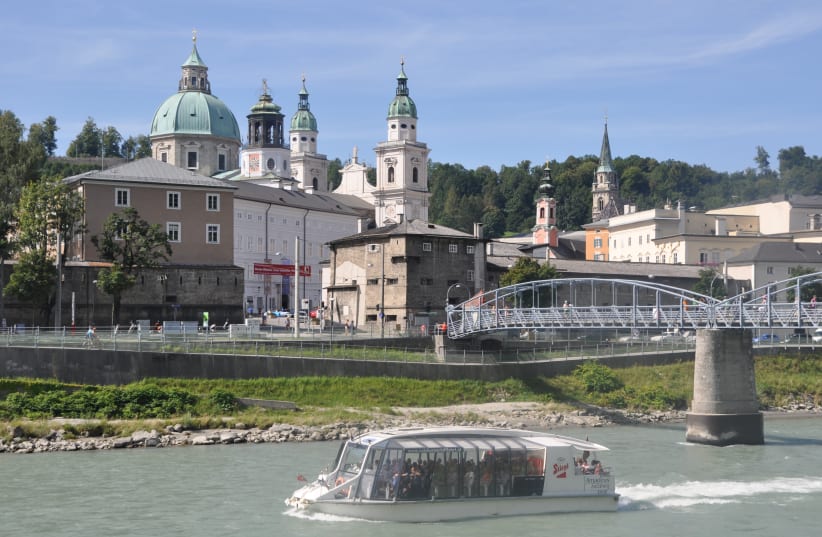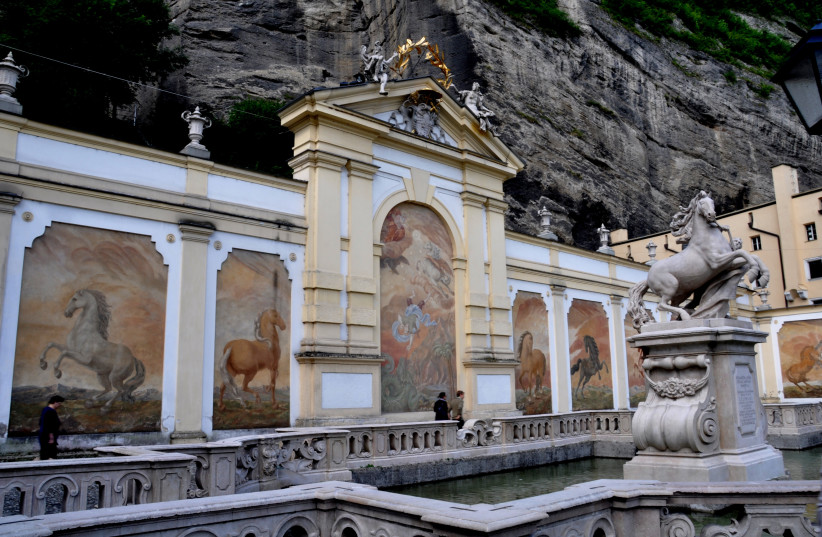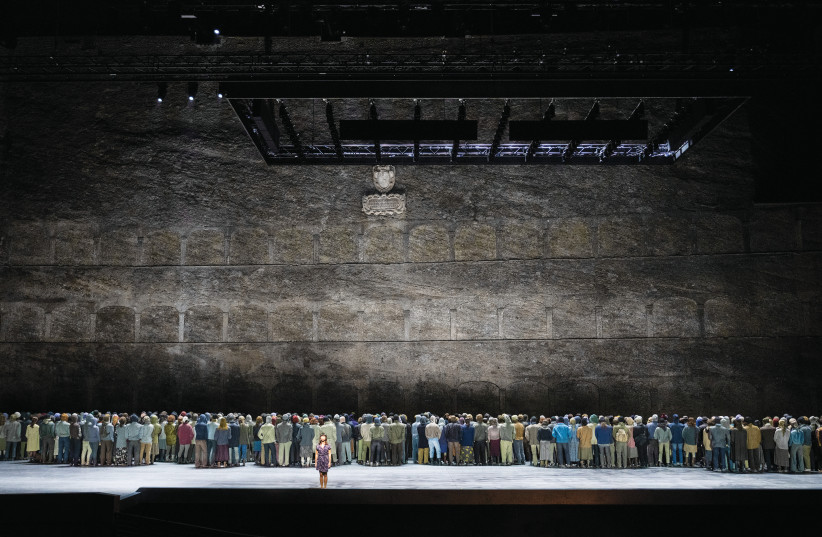Salzburg, the birthplace of Wolfgang Amadeus Mozart, has treated its most illustrious son far better in death than in life. Through shrewd public relations and astute marketing, the city has become a magnet for music lovers; and the summer festival, with its impeccable musical standards, represents the Olympus of all festivals. It also has the dubious distinction of having the highest ticket prices.
The original idea of the festival was conceived in 1920 by an illustrious trio comprising stage director Max Reinhardt, novelist, and poet Hugo von Hofmannsthal and composer Richard Strauss. Their idea of brotherhood among nations through music came in the aftermath of the First World War. They brought the best artists every summer to Mozart’s birthplace.
Of interest is the Jewish associations of the founders. Reinhardt was Jewish, Hofmannsthal’s family was originally Jewish but had converted to Catholicism. Strauss had a checkered history and initially supported the Nazi regime. Because of this, performances of his music were banned in Israel, although today it is widely performed. Strauss’s son married a Jewess, and his grandsons were Jewish.
The Salzburg festival is probably one of the last remaining bastions of old-world elegance. Even in matinee performances, women are often attired in long evening gowns, and men in tuxedos.
What is the Salzburg festival like?
AS USUAL, operas featured prominently in this summer’s festival program. There were nine productions: four new, three revivals and two non-staged. Pride of place went to Puccini’s Il Trittico (The Triptych), his penultimate major opus, which consists of three unrelated one-act operas. Traditionally, Il Trittico begins with Il Tabarro (The Cloak), followed by Suor Angelica and concludes with the comedy Gianni Schicchi.
However, stellar Lithuanian soprano Asmik Grigorian was on board for the three soprano roles. She achieved universal acclaim with her interpretation of Salome in Salzburg four years ago. Since then, she has triumphed in major roles all over Europe. Famed opera director Barrie Kosky has quipped that Grigorian “could sing the telephone book and it would be fabulous.”
Because of her presence, director Christof Loy reversed the order of this triple bill. Initially, we saw Grigorian as an innocent teenager in love. Next, as an older unhappily married woman, and finally as a young novice in a convent. The soprano role in Gianni Schicchi is minor, builds up significantly in Il Tabarro and is dominant in Suor Angelica, which ends with a dramatic monologue. Thus Loy’s ploy of reversing the acts made vocal sense.
Gianni Schicchi, set in medieval Florence, is based on an episode from Dante’s Divine Comedy. Grigorian was the young innocent Lauretta, daughter of the wily Gianni Schicchi. Her role, minor in this opera, did however include one of the most beloved soprano arias in the whole operatic repertoire, “O mio babbino caro” (Oh my dear papa). Not unexpectedly, Grigorian carried this off with aplomb, portraying the innocence of a young teenager in love.
Then followed “Il Tabarro.” Here, Grigorian was the desperately unhappy Giorgetta, wife of the barge owner Michele. She has a love affair with the stevedore Luigi. The latter is murdered by Michele and concealed in his cloak.
Finally, Grigorian featured as the novice nun Suor Angelica, a daughter of an aristocratic family. She disgraces them by having a child out of wedlock. To atone for her sin, the child was forcibly removed from her at birth, and Angelica was confined to a convent by her aunt, La Zia Principessa. The drama reaches its peak with the encounter between Suor Angelica and her aunt, whom she had not seen for seven years. The Principessa forces her to renounce her inheritance. Without the slightest empathy, she told Angelica that her son had died two years previously.
Veteran Finnish soprano Karita Mattila took on the challenging role of the Principessa. She and Grigorian had a soaring dramatic encounter, one of the real momentous moments of the festival.
After the Principessa’s exit, Suor Angelica was presented with a suitcase containing a picture of her son, some of his possessions, as well as a few of her previous belongings. She strips from her nun’s habit, undoes the braid in her hair, dons an elegant black dress, lights a cigarette and mixes a poisonous herbal concoction, which she drinks and commits suicide.
Realizing that suicide is a sin, she begs the Virgin for forgiveness. The curtain falls as she enters heaven and is united with her son.
Grigorian gave a towering, searing unforgettable tour de force performance of her monologue, demonstrating her formidable acting ability and vast dynamic vocal range, and unleashing shattering fortissimos, as well as tender pianissimos.
In the pit was the dependable Vienna Philharmonic Orchestra, conducted by Franz Welser-Most, who elicited a vibrant and sensitive performance and succeeded in bringing out the subtleties of the score.
The impressive baritone Misha Kiria, as Gianni Schicchi, stood out for his unusually rich characterization of this role.
In Il Tabarro, tenor Joshua Guerrero as Luigi sang ardently and dramatically and was more than equal to the task. Baritone Roman Burdenko was Michele. He brought out the unrequited love, poignancy, anguish, sorrow and ultimately brutal violence essential to the role.
ANOTHER NOTABLE production was Leos Janacek’s three-act opera Katia Kabanova. This opera was inspired by Janacek’s infatuation with his muse, Kamila Stosslova, and was dedicated to her. Janacek was almost 40 years Kamila’s senior, and although they were not emotionally involved, his passion for her inspired the extraordinary late flowering of his music.
The opera is set in a small town on the Volga River and revolves around a dysfunctional family. Katia is an emotional religious girl who is in a loveless marriage.
Kosky, recognized today as one of the most innovative operatic directors, utilized all his skills in Katia Kabanova and masterminded a stunning production. To maintain the dramatic tension of the work, the three acts were performed without an intermission. The opera was staged in the Felsenreitschule (Riding School), one of the major venues of the festival. This comprises 96 arcades hewn out of rock. Kosky covered all the arcades to create a more intimate atmosphere.
In addition, he populated the massive stage with hundreds of dummy figures dressed in contemporary clothes with their backs turned on Katia, emphasizing the fact that she was alone in a most uninviting environment. Other cast members emerged from this anonymous crowd. At the opera’s conclusion, real human villagers mingled with the models and were active onlookers on Katia’s ultimate tragic suicide.
The role of Katia was taken by soprano Corrine Winters. She demonstrated extraordinary passion, both vocally and physically, and gave an inspired, riveting performance. An enduring image of Winters was her running wildly, aimlessly across the giant stage, with nowhere to go and no help at hand.
Conductor Jakob Hrusa, who hails from Brno, the city where the opera premiered, directed a nuanced, richly textured performance with the Vienna Philharmonic. He succeeded in capturing Janacek’s emotional rhythmic melodies which progressively gather increasing momentum.
ROSSINI’S EVER-FAVORITE comedy The Barber of Seville was originally staged at the recent June Salzburg Whitsun Festival by artistic director Cecilia Bartoli. It received a revival at the current festival and was also unquestionably another dramatic high spot. Rossini worked prodigiously fast and claimed to have written the score in 13 days, to which the composer Donizetti is reported to have said, “Ah, yes, but Rossini was always a lazy fellow.”
Bartoli herself took on the challenging role of Rosina, which was her professional debut role 35 years ago. Clearly, her voice has lost some of its luster over the decades but is still remarkable, and the trills were still amply evident. This, coupled with her extraordinary flirtatious stage presence and body language, made her the heart and soul of the performance.
Tenor Rolando Villazon, in his newly found role as an operatic director, took an intriguing approach by setting his innovative production in an art deco film studio with vintage projectors at the time of silent black-and-white movies. Dominating the production was the ever-present Italian actor Arturo Brachetti in the nonspeaking role as the movie projectionist.
During the overture, Brachetti is seen embracing a poster of Cecilia Bartoli depicted as Ceci. B. Artoli, a takeoff ploy on the famous American film director. Bartoli is then seen in black-and-white film clips as Joan of Arc, a pirate, a nun and even as Cleopatra.
When the film shifts to Once upon a time in Sevilla, the singers emerge from the movie and the action begins. Brachetti is the link between the evolving plots. The frequent movie projections were entertaining but perhaps somewhat overdone. A nice touch showed Bartoli confined to a cage by her frustrated and ultimately duped suitor, Don Bartolo. This was sung by veteran baritone Alessandro Corbelli, who played his role with style and finesse.
Baritone Nicola Alaimo as Figaro moved around on a scooter and, with his rich, smooth voice, was vocally most satisfying and brought power and authority to the role. Tenor Edgardo Rocha, was Count Almaviva, Rosina’s determined suitor. He began a little tentatively but eventually proved worthy of the role. True to form, at the conclusion, we see Count Almaviva already flirting with new potential conquests.
Don Basilio, the music instructor, was beautifully sung and acted by bass Ildebrando D’Arcangelo. He was shown as a vampire-like character with pointed ears and long fingernails. His aria “La Calunnia” (The Slander) was one of the great moments of the evening.
The ensemble Les Musiciens du Prince–Monaco with period instruments under Gianluca Capuano joined in the fun and proved to be an integral and worthy partner in this delightful endeavor.
Act Two featured the rarely heard duet “Ah piu lieta” (Ah more happy), sung by Almaviva and Rosina. In most performances of this opera, this aria is usually omitted. It was later reused by Rossini in the conclusion of his opera La Cenerentola (Cinderella). In the current performance, this duet prove to be a real knockout and was encored. Indeed, this whole exhilarating operatic performance so enthralled the audience that the finale was also repeated, a rare occurrence in opera in general and Salzburg in particular.
When Rossini and Beethoven met in Vienna, the latter is reported to have said somewhat condescendingly to Rossini, “Above all, compose a lot of Barbers.” Luckily for posterity, Rossini took this sage advice.THE GREEK conductor Teodor Currentzis, who trained in Saint Petersburg, is currently a most sought-after musical celebrity. In 2004 he founded the Orchestra MusicAeterna, which until 2019 was the resident orchestra at the Perm Opera in Siberia.
This orchestra, together with Currentzis, has featured prominently in previous Salzburg Festivals. One of the major supporters of MusicAeterna is the Russian VTB Bank, currently sanctioned by the West. Because of this, MusicAeterna has been blacklisted in several countries. Humanity is the ultimate loser when music is dictated by politics. We witnessed this previously in Germany in the 1930s and ’40s.
Salzburg Festival’s artistic director, Markus Hinterhauser, invited MusicAeterna to participate in the current festival. Under Currentzis, it performed Shostakovich’s 14th symphony set to 11 poems all based on the theme of death. This was an incandescent dramatic performance, with outstanding contributions by soprano Nadezhda Pavlova and baritone Matthias Goerne.
The second half of this program was devoted to a concert performance of Purcell’s Dido and Aeneas. A strange coupling, but with the charismatic Currentzis at the helm, it worked out well. My final take-home moment of this wonderful sojourn of music in Salzburg was the glorious lament, the conclusion of Dido and Aeneas, by mezzo Kate Lindsey. This was absolutely heavenly, and it still rings in my ears.■
The writer, an emeritus professor of medicine, currently writes, reviews and lectures on music, art, history and travel. www.irvingspitz.com, irving@spitz.com


